A visit to town at
WUBIN
Once or twice a week, it would be necessary to make a trip into town to purchase provisions and socialise. As a young teenager, these are my recollections of a trip to town, so together let's now go on a tour of the town. They are recollections based on memory, not necessarily fact.
My grandparent's farm was south west of Wubin, so we would drive along the gravel road, past the golf course and sports ground, turning left onto Great Northern Highway at the southern approach to Wubin. First stop would be the post office, to collect the mail.
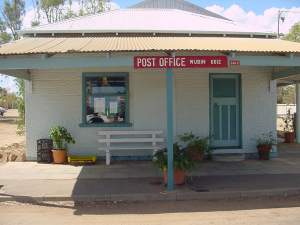
Growing on the opposite side of the main road to the post office was a large gum tree, which provided shade from the hot sun. The car would be parked in the shade of that tree, and we would walk across the road to the Post Office. The Post Office was a small cement brick building with an iron roof. The post boxes were located on the front wall of the building, but it was always necessary to enter and talk with anybody inside. The building contained a wooden counter, and behind the counter, a table on which mail was sorted. Up to the mid seventies, the telephone exchange was also housed in this building. The postmaster was responsible for operating the manual exchange, answering and connecting phone calls, in between serving postal customers and sorting the mail. Mail was franked in full view of the customer, and placed in a canvas bag for later delivery. There were two slots under the front window through which mail could also be posted, and they dropped directly into a postal bag on the other side of the wall. Now days, a red post box sits at the front of the post office, serving the same function. The boxes for collecting mail have now been relocated to the southern side of the post office, and tourist information is located where they used to be. Outside the post office was a public telephone box, a standard PMG red wood and glass phone box. There were two public telephone boxes in Wubin, the second was located outside the Shell service station, and was the more modern aluminium and glass construction.

Having collected the mail, it was time to do the shopping. Leaving the Post Office, we head north along Great Northern Highway, to turn right onto Glowery Street. On the corner is the tallest building in Wubin, the Wubin Hotel. The tallest that is, if you overlook the huge wheat silos towering over the town from the other side of the railway line. But certainly, as the only two storey building in the town, it is the tallest habitable structure. Built in 1934, it has served as a meeting point for many people over the years to discuss and argue many a subject. There are also more modern motel units adjacent to the hotel building to provide accommodation to travellers.
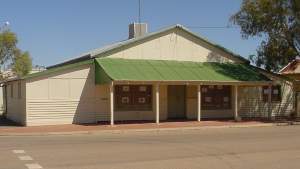
We drive along Glowery Street to the corner of Arthur Street, a distance of only about 200 metres. This was the main store in the town, where just about anything could be purchased. Built in 1929, the timber, asbestos and iron building has been the source of many purchases for many people, over the years. Walking up to the doorway, it was obvious that it was a focal point for townspeople, the wooden step was well worn down with countless numbers of feet treading on it over the years. Inside were two wooden counters with cash registers, at which the purchases could be paid for, but it was primarily a self-service supermarket style shop. In the main part of the building were aisles of grocery items and foodstuffs. An annexe on the southern side of the building contained hardware, tools and other items essential to farming. Across on the other side was a clothing section, or somewhere that you could find a gift. Assistants would provide service with the fresh fruit and vegetables, weighing produce with scales suspended from the roof structure. Ice cream and frozen purchases would be wrapped in many layers of newspaper to ensure that they did not thaw out too quickly on the trip back home. And if you were not able to pay, you could always "book it up" - the cost of purchases noted down in a book, to be paid off at the end of the month.

After paying for the purchases at the Wubin Trading Co, it was a walk down the street to the bakery. On the way, we pass a number of empty shops. The first is probably the smallest building in the whole town, with a street frontage of just 4m. In the 1930s and 40s it was the butcher's shop, but has not been used as a shop for many years. Then there was another building of two empty shops. Again, these have not been used as shops for many years, but once housed a variety of shops including a dressmakers, and a lolly shop.

Then to the bakers. Originally, the bakehouse was a separate corrugated iron building at the rear of the shop where the baker slaved over a hot oven in the early hours of the morning to have the bread cooked ready for the customers who would arrive later in the day. By the seventies, it was more economical to sell bread that had been baked in Dalwallinu and delivered by truck. By the eighties, competition meant that the bread was sold at the Trading Co, and the bakery closed it's doors.
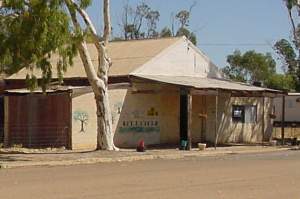
Before walking back down the street, there are a couple of other buildings to look at. Next to the bakery was a disused garage. Owned and operated originally by Bill Cook, it closed in 1963. However for a time it was one of four places that petrol could be purchased in Wubin. If you wanted Caltex, you stopped at Newby's service station at the southern end of town, if you wanted Shell you visited Bill Cook's garage. The Post Office sold COR (Commonwealth Oil Refinery, later BP), and Neptune fuel was available from the Wubin Trading Co. Bill Cook also sold Vacuum Oil products, so the famous Pegasus trademark (the "flying red horse") was displayed on the front of the building. The faded sign at the rear of the building still proudly displays "Cooks Garage" but the front verandah shown in the photo on the right was blown off a couple of years after the photo was taken, but repaired for the centenary celebrations in 2008.
There is only one house left before the end of the street, a private residence. Across the other side of the street are a couple more private residences. Snowy Thomas once owned the one on the northeastern corner. He worked for the local blacksmith, but also excelled in making tanks. Completed tanks were stored on the vacant land behind his house, scattered here and there, waiting to be sold.
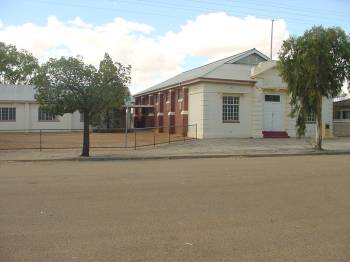
As we walk back along Arthur street, on the other side of the road, we come to the Town Hall. This is an imposing structure, and was another focal point for the community. Built of brick, with an iron roof, it was officially opened on Easter Monday in 1936. It was provided with the modern convenience of electric lighting, supplied by a diesel engine and 32 volt dc generator. A supper room was constructed on the north side of the hall in the 1950s, on the site of the original community hall. The original hall had been built around 1921, but was not a substantial structure and was eventually demolished. The hall was used for community events, socials and church meetings.
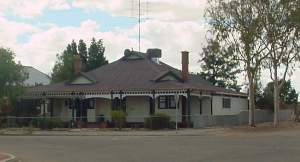
The next house is a large and impressive looking building. In the early 1920s, Harold and Flora Smith lived in Wubin and operated the local store, in partnership with Harold's brother in law, John Parrott. The store was known as Smith and Parrott's. It burnt down in 1928, and the Wubin Trading Co was built to replace it. Harold Smith had commenced farming on a block west of Wubin, but was tragically murdered in June 1928. His widow and 3 daughters were destitute, but a public fund was sponsored by the R.S.L. and resulted in the building of this house. Mrs Flo Smith ran it as a guesthouse for 11 years through to 1940. Since then it has been used as a private residence.
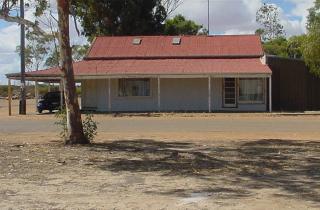
Across on the other side of Glowery Street, is a building which used to house the local branch of the Dalwallinu Farmers Cooperative Limited, from 1936 to 1960. This was when there were enough residents in the community to be able to support a number of general stores. By the 1970s it too had become a private residence only. At the south end of this building was a small room that served as the local branch of the Bank of New South Wales. Every week on Thursday morning, a representative from the Dalwallinu bank would come up to Wubin to provide banking services to the people of the Wubin district. If we were in town on Thursday morning, then it would be necessary to walk across the road to visit the bank, and withdraw enough cash to last the week.
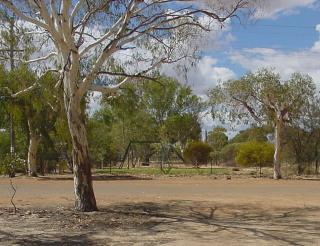
The CWA room is the next building along the street. Is it still used? I doubt it. It was, however, restored and repainted in time for the centenary celebrations in 2008. Next door is a playground, with a few swings and slides that have been well used over the years. And between there and the southern end of town, one more private residence.
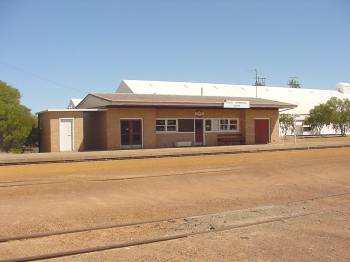
Generally that would be the end of the visit to town. Occasionally, there would be a need to go across to the railway station to pick up a parcel. Sometimes we would stop at one of the service stations for a part for a motor vehicle. Generally, after doing the shopping, and catching up with whomever may have been in town, it was back home as quickly as possible before the frozen goods melted, or the ice-cream turned to milk.